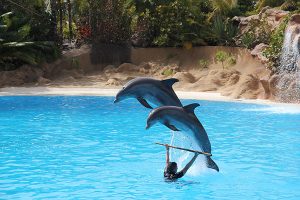Films; A Hollywood Horror For Marine Life? Part 2
 Last month we looked at how the film industry can have an impact upon marine life and conservation efforts, and in particular how the film Jaws (1975) affected sharks. This film and of course other shark-centric films seem to focus on the idea that sharks are dangerous man eaters that hunt people for revenge when it simply isn’t the case. As a result, people appeared to have developed more of a fear and increased hunting leading to a sharp decline in shark populations – a very negative effect. However, there was also an increase in funding and research into the lives of sharks so it also appeared to produce a positive effect. When looking at the impact that Jaws had on sharks, there wasn’t necessarily a clear-cut answer – peoples’ fear and avoidance had both good and bad consequences.
Last month we looked at how the film industry can have an impact upon marine life and conservation efforts, and in particular how the film Jaws (1975) affected sharks. This film and of course other shark-centric films seem to focus on the idea that sharks are dangerous man eaters that hunt people for revenge when it simply isn’t the case. As a result, people appeared to have developed more of a fear and increased hunting leading to a sharp decline in shark populations – a very negative effect. However, there was also an increase in funding and research into the lives of sharks so it also appeared to produce a positive effect. When looking at the impact that Jaws had on sharks, there wasn’t necessarily a clear-cut answer – peoples’ fear and avoidance had both good and bad consequences.
So, what happens if people don’t want to avoid the animals they’re watching on screen and instead want to see them in real life? What if they want to see the animals doing what they do in the films but close up without the fourth wall? Very often issues can arise from people wanting to approach not avoid, as appears to have been the case with Flipper (1963).
**************** **************** ****************
Flipper began life as a film about two children and their adventures with a bottlenose dolphin. Released in 1963, it went on to become a television series between 1964 and 1967, another television series between 1995 and 2000, and a film re-make which was released in 1996. It was a very popular genre, with the grace and beauty of the dolphins capturing the public’s imaginations, and indeed their hearts. Demand grew for opportunities for people to go out and see dolphins up close for themselves. However, this wasn’t in the form of boat trips to watch them frolicking in their natural habitat but instead a drive towards the construction of more dolphinaria.
This dolphinarium craze quickly spread around the globe. The industry grew in strength and was worth billions, with visitors all desperate to see these wonderful animals and their “amazing” tricks. At this time the effect of captivity on dolphins was relatively unknown and so no one was entirely aware of what a devastating impact the conditions they were forced to live were having upon them. As far as many people were concerned, the dolphins looked happy and so they probably were.
Nobody seemed to know that the chemicals were blinding, and that their lifespans would decrease by over 75%. Nobody seemed to realise that their tanks were far too small and were restricting them from swimming the countless miles they travelled each day in the wild before being plucked out of the sea. Nobody seemed to understand that the dolphins weren’t actually smiling, they were suffering.
Ric O’ Barry, the man who helped to capture and train the five female bottlenose dolphins used in the Flipper film and TV series in the 1960s, certainly didn’t have any idea of what they were going through. He enjoyed his job working with the captive dolphins. That was until he witnessed what he believes to be one of the dolphins committing suicide in front of him by purposefully not surfacing to breathe. Kathy, who was the main Flipper dolphin most of the time, died in his arms. After that, he began campaigning to stop dolphins being snatched from the wild and sent to dolphinaria. Today he firmly believes that they are better off in the wild which is a view that, thankfully, many people also believe. Now an increasing number of people are aware of the dangers and suffering that captive dolphins are subject to and so opt out of visiting dolphinaria, and instead opt in to boat trips to watch them in the wild.
However, sadly that isn’t the case for everybody. Taiji, a small fishing town on the coast of Japan, is renowned for its annual dolphin hunting season, and it’s a place that Ric O’Barry knows well through his work to end captivity. It is here that many dolphins from seaquaria and dolphinaria all over the world are captured and sold into for ridiculous amounts of money. Live dolphins, according to Ric O’ Barry, can be worth around £96,000, providing a clear financial motive to the fishermen who capture them. Other dolphins who are caught in the cove that aren’t sold to perform are slaughtered and their meat sold. It is a shocking situation and it’s even more shocking that such a practice still happens today.
After witnessing Kathy’s death, Ric O’ Barry began campaigning to put an end to dolphin captivity. In 1970, on the first ever Earth Day and in the years since, he has helped to rehabilitate and rescue dolphins in countries all over the world including Nicaragua, Japan, the United States of America to name a few. His organisation, ‘Dolphin Project’, is the longest running, anti-captivity organisation in the world and continues to make a difference today.
Nobody will stop fighting until the suffering of captive dolphins stops.
But can captive marine mammals really be returned to the wild?
Free Willy (1993) is another film which popularised cetaceans and grabbed peoples’ attention. It tells the tale of a captive orca, his human friend, and their fight to return him back to the open ocean and to his family. Ironically, the whale who played Willy, named Keiko, had also been snatched from the wild and away from his family in the freezing cold waters of Iceland. However, unlike his character, his release was not so successful.
Following the film’s release, there was a surge in people writing to campaign for Keiko’s release. This time, contrary to Flipper, many of the viewers didn’t want to see killer whales up close within touching distance and performing in captivity. They wanted to see them wild and free. Keiko’s owners, feeling the public pressure, eventually transferred him to Iceland where he was encouraged to swim out and join a local orca pod. However, he didn’t appear to know what to do, and he struggled with his new life. He seemed to simply drift along and didn’t appear to have eaten ten days later when he returned to his ocean pen by himself. Keiko just didn’t show signs of having any of the social and survival skills needed for a life in the sea.
He managed to migrate to Norway (tracked with a radio tag by Sea Watch’s former monitoring officer, Fernando Ugarte, and colleagues), but that is where his life in the wild came to an end. After approaching people and boats, he seemed to become overwhelmed by the number of people beginning to approach him, trying to touch him. He was taken to a new pen out of the way but sadly passed away, possibly of pneumonia, just one year later.
Sometimes rehabilitating whales and dolphins just doesn’t work, but that’s not to say this is the case every time. Dolphins have been successfully released in the Turks and Caicos Islands, in Brazil, the United States of America, Guatemala, Nicaragua and Russia. It can be done, but strict guidelines need to be in place to ensure a successful release. They should be close to pods with which they would normally associate, and they should be released in clear unpolluted water, although sadly this is somewhat of a challenge nowadays! They should be able to feed themselves, be disease free and under no circumstances still retain behaviour that would put them at risk, for example by approaching humans for contact. Some animals may not be healthy enough and some may be too psychologically scared to survive on their own, but that does not mean they should spend the rest of their lives in a small, cramped tank. They should be given the chance to spend the rest of their days in peace in an enclosure. They all deserve a chance to be happy.
So, films can sometimes be a force for good but they can also have negative consequences. Flipper piqued people’s interest in dolphins but also led to a rise in dolphinaria and forced performing. Free Willy made people aware of the plight of captive cetaceans but Keiko’s release wasn’t the success that everybody hoped. Determining what impacts films can have is a bit of a tricky one. However, what they do do is increase interest and perhaps it’s is through this that more campaigns will be set up and supported. Perhaps if films encourage people to learn more about the animals themselves and discover the threats they face without necessarily being influenced by storylines and characters, then maybe more positive action will be taken. The more people talk about issues and debate film content, the more the plight of these animals will be heard.
Films don’t have to be a Hollywood horror in the world of marine life.
Written by Arianne Kenworthy
